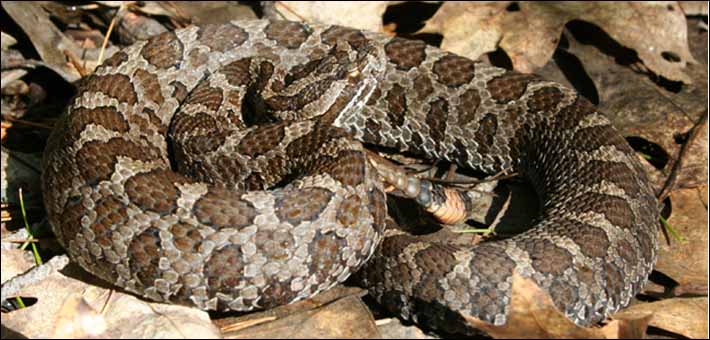
Massasauga rattlesnake, the most northerly rattlesnake in the US. Image: Joe Crowley/US Fish & Wildlife Service
By Eric Freedman
What’s on the menu today?
If you’re an eastern massasauga rattlesnake in Michigan’s Lower Peninsula, the main course on your menu is likely to be small mammals like meadow voles and masked shrews, with an occasional side order of bird and snake.
Yummy!
A recent study by Grand Valley State University scientists who researched what Michigan’s only venomous snake eats found that eastern massasaugas “strongly prefer small mammal prey, yet individuals occasionally consume other prey, including amphibians, reptiles and birds.”
The eastern massasauga spends most of its time in year-round wetlands hunting its primary prey, according to the state Department of Natural Resources. The department says the rattler is a “rare sight for most Michigan residents (and) has been declining due to fragmentation and loss of wetland habitat.”
Lead researcher Alyssa Swinehart said the snakes’ main prey prefer living in wetlands areas with open tree canopies, so it’s important to preserve areas that are hospitable to such small mammals as shrews and voles.
Such areas are vulnerable to encroaching invasive plant species such as the glossy buckhorn, according to Swinehart, who is now a lab technician at Grand Valley State. She said she “had always liked snakes and wanted to work with reptiles” so undertook the project for her master’s thesis in biology.
The U.S. Fish and Wildlife Service, which helped fund the project, classifies the massasauga as threatened under the Endangered Species Act.
The Grand Valley State team conducted field research in Montmorency, Crawford, Lenawee, St. Joseph, Oakland, Manistee, Barry, Kalamazoo and Alcona counties and on Bois Blanc Island in Lake Huron east of Mackinac Island. Their study published in the journal “Ecology and Evolution” didn’t identify specific locations “to prevent illegal collection.”
It was the first time that researchers used a recent technique called “DNA metabarcoding” to test the content of snake feces, although it’s been used to study what other wildlife species eat.
Each species has a unique bar code, Swinehart said.
The analysis found that eastern massasaugas are “somewhat opportunistic predators” and identified at least 12 prey species for adults and a smaller number for younger snakes. Among the most common menu items were northern short-tailed shrews, woodland jumping mice and white-footed mice.
“We conclude that small mammals are a crucial part of eastern massasauga rattlesnake diet and recommend this be taken into consideration when conservation strategies are developed,” the study said.
Study co-author Amy Russell, a Grand Valley State biology professor, said, “We now have a much more accurate characterization of what those prey species are for the eastern massasauga rattlesnake, whether it varies by geographic region or whether it is different for older and larger snakes versus younger and smaller snakes.”
“This will allow (land and natural resource managers) to get a more finely resolved assessment of whether a particular property is really valuable as potential eastern massasauga habitat and whether it is likely or not to support a self-sustaining population,” Russell said.
Swinehart said the team also documented some prey species in places that previous research hadn’t found, including the star-nosed mole, northern water snake, field sparrow, red-backed salamander and southern bog lemming.
A “cool byproduct” of the project was discovering changes in where some prey species can be found in the state, she said. For example, the woodland jumping mouse, which is “more of a northern Michigan species,” was identified for the first time in some southern Michigan locations.
Swinehart said the team hopes the findings will help other researchers who study snakes and reptiles to use DNA metabarcoding.
Meanwhile, her lab’s current project, funded by the Little River Band of Ottawa Indians, is using that technique to determine the diet of American martens in the Huron-Manistee National Forest.
